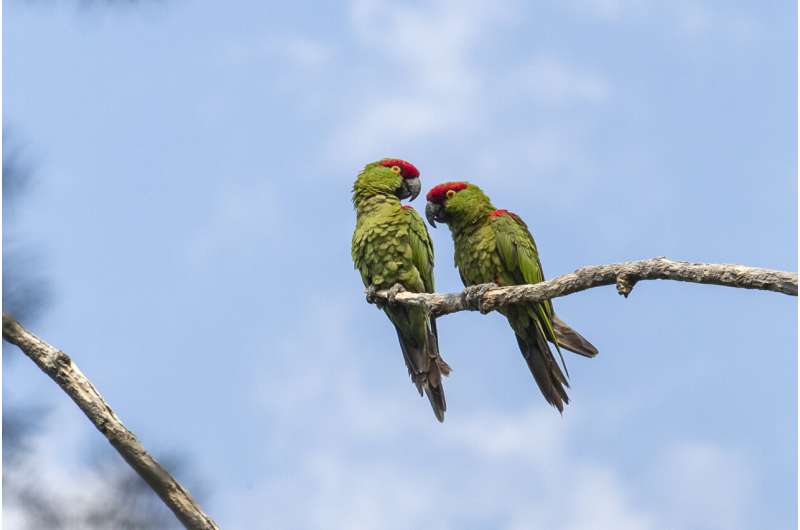This article has been reviewed according to Science X's editorial process and policies. Editors have highlighted the following attributes while ensuring the content's credibility:
fact-checked
peer-reviewed publication
proofread
Endangered thick-billed parrots at risk of losing unprotected Sierra Madre forest habitats to logging, deforestation

A binational team of scientists, using creativity and innovation, adorned dozens of endangered thick-billed parrots with tiny solar-powered satellite transmitters to track and reveal their winter migratory nesting sites in the remote treetops of the Sierra Madre Occidental ranges. Their research reveals new critical habitat, 80% of which has no formal protection.
In their study published this month in Global Ecology & Conservation, researchers from San Diego Zoo Wildlife Alliance and Organización Vida Silvestre A.C. (OVIS) in Mexico were able to track the birds that soar high above the rugged pine forests of Mexico, terrain too difficult for researchers to follow. The research was led by James Sheppard, Ph.D., and SDZWA Recovery Ecology Senior Scientist.
"Until now, it was a mystery where thick-billed parrots overwinter and the sites where they nest along the way, creating a difficult challenge for efforts to conserve this species," Sheppard said. "We have now identified new, critical habitat and migratory routes for thick-billed parrots as well as steps that need to be taken to protect them."
The charismatic thick-billed parrot, the only living parrot species native to the United States, once thrived in parts of Arizona and New Mexico in the U.S., and as far south as Venezuela. Due to habitat loss, illegal hunting and predation, an estimated less than 2,000 thick-billed parrots remain in the wild, and only in the pine forests of Mexico.
"Prior to this study, there was only anecdotal evidence to suggest where thick-billed parrots spent their breeding and overwintering seasons," said Ernesto Enkerlin-Hoeflich, OVIS Director for Science. "Now we can show the birds spend their breeding season mostly in the states of Chihuahua and northern Durango then overwinter in the south-central Sierra Madres, and we can share this information with regulatory agencies and engage them and the conservation community to protect the forests the parrots need to survive."
The study shows parrots require old-growth forests comprised of mature pine trees that provide nesting hollows and pine nuts for food. Less than 1% of the old-growth forest that once covered the Sierra Madre Occidental remains, Sheppard said.
"Strikingly, less than 20% of the newly identified thick-billed parrot overwintering habitat is protected from the timber industry and common clear-cutting practices," Sheppard said. "Further, existing networks of protected sites may not be adequate for the parrots' survival as a changing climate increases the intensity and frequency of forest fires as well as exacerbated pine beetle outbreaks, which can devastate a previously healthy forest. The good news is, we understand what's needed to save this iconic bird."
Data collected was the result of a three-year effort that started after Sheppard convinced a technology company to sell SDZWA the supplies that the team used to construct the silver-dollar sized transmitters or "backpacks."
"They weren't going to sell us the technology because they didn't think it was possible to attach GPS transmitters to these strong, boisterous birds," Sheppard said. "But we convinced them and proved it could be done."
Since first attaching the solar-powered transmitters, researchers have acquired a data set of more than 40,000 locations remotely from the tracked parrots, enabling the discovery of a new nesting location as well as their overwintering home ranges, migration paths and stopover sites.
"Now, with the sustained engagement of local stakeholders, we hope to successfully recover wild populations of thick-billed parrots as well as old-growth forests, and perhaps one day, use this information to reintroduce thick-billed parrots to their former ranges, including in the U.S.," Sheppard said.
More information: James K. Sheppard et al, Spatial behaviors and seasonal habitat use of the increasingly endangered thick-billed parrot (Rhynchopsitta pachyrhyncha), Global Ecology and Conservation (2023). DOI: 10.1016/j.gecco.2023.e02712
Journal information: Global Ecology and Conservation
Provided by San Diego Zoo Wildlife Alliance



















